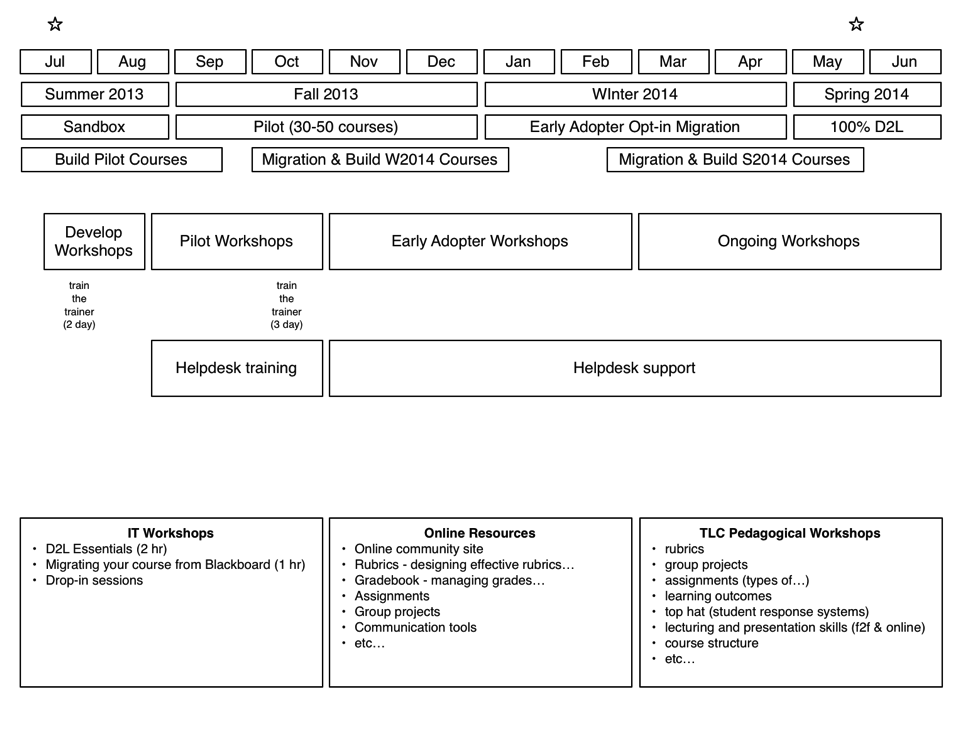So, we’re moving to Desire2Learn. Lots of things happening to get us there. Everything is being driven by a timeline leading to the decommissioning of our old LMS on May 31, 2014. Which means, when dealing with academic calendar years, and semester cycles, that we have 3 semesters to get from 0-100% adoption of D2L before we turn off the Blackboard servers.
I know. The timeline is kind of crazy. But, it’s totally doable. We’re going to have to be OK with noise and mess, and with not having all of the answers ahead of time. We’re going to be needing a lot of support from Desire2Learn (thankfully, they’re up to it), and from the UofC community as a whole.
I got tasked as the project manager for the migration, which is loaded with pros and cons. Perhaps those are better for other posts… But, it means I’m the deer stuck in the headlights, trying to figure out how to get us from A to B before A disappears.
Here’s the rough (non-contractual, will vary wildly, high-level) overview timeline:

(note that the bottom 3 boxes aren’t actually in the “timeline” but were dropped in as a result of a training brainstorming session. Top part of the diagram is a timeline, bottom part not so much. confusing? maybe.)
The first star is when we anticipate getting access to our hosted instance of D2L. The second star is when we need to turn off our Blackboard 8 servers. Everything is scheduled around getting between the two stars.
Summer 2013 (July – August) – We’re going to start with some volunteer/recruit instructors building their courses in a “sandbox” environment while our production and test environments are spun up. When the production environment is ready, we’ll move the courses over manually. During this time, we’re getting our heads around Desire2Learn. Several UofC folks are going to Desire2Learn Fusion. D2L is going to be working on campus to do the implementation consulting and initial setup. Busy couple of months…
Fall 2013 (September – December) will be a small-scale pilot deployment, with 30-50 courses. Small-scale is important, because we won’t have PeopleSoft integration yet (although we should have CAS single-sign-on integration). Fall is going to be messy, as integration is implemented, and tools are integrated. We’ll pilot workshops and training resources. We’ll hopefully iron out the key issues. And then brace for…
Winter 2014. January – April. Currently, I’m hoping to run it as an opt-in migration. Any instructor (or department or faculty) that wants to move to D2L will be able to do so. But, you don’t have to migrate yet. Blackboard 8 will still be ticking along until the end of the semester.
Spring 2014. May – June. We will have to throw the switch. Blackboard will not be available for use in courses beginning with this semester. All courses in Blackboard will be exported and archived (and freeze-dried in an offline storage vault somewhere). The Blackboard server will be mothballed, likely only turned on in response to an appeal from students, or at the request of the auditor general’s office (or some similar governmental body).
Summer 2014 – ramping up training for the fall semester, which will be the biggest semester since cutover.
Fall 2014. This is when stuff really hits fans. All of the folks that resisted early adoption now will have to use D2L. We’re going to be training and working with every instructor to get them up to speed. Hopefully, the remaining instructors were proactive and came to workshops over the summer, to prepare for the transition. Lots of workshops and community events. Good times.
So. Yeah. Crazy timeline. But there’s not really an option. The current LMS gets mothballed in 11 months. If we don’t have all 31,000 students, and all instructors and staff, moved over by then, we’ll have bigger problems than optimistic timelines…
I’m actually very optimistic to see what our community will do with D2L as a foundation of our eLearning environment. Early responses are extremely positive. We have a lot of work to do, to get fully implemented and integrated, but once it’s up and running, I’m confident our community will do some pretty cool things with it.
And – the most important part – they’ll be able to move past the tool and focus on pedagogy, teaching, and learning. The tool moves out of the spotlight, and becomes an enabling platform for the stuff we really care about.